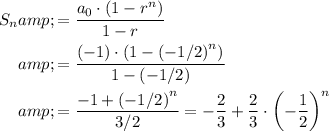Answer:
This series is convergent. The partial sums of this series converge to
 .
.
Explanation:
The
 th partial sum of a series is the sum of its first
th partial sum of a series is the sum of its first
 terms. In symbols, if
terms. In symbols, if
 denote the
denote the
 th term of the original series, the
th term of the original series, the
 th partial sum of this series would be:
th partial sum of this series would be:
 .
.
A series is convergent if the limit of its partial sums,
 , exists (should be a finite number.)
, exists (should be a finite number.)
In this question, the
 th term of this original series is:
th term of this original series is:
 .
.
The first thing to notice is the
 in the expression for the
in the expression for the
 th term of this series. Because of this expression, signs of consecutive terms of this series would alternate between positive and negative. This series is considered an alternating series.
th term of this series. Because of this expression, signs of consecutive terms of this series would alternate between positive and negative. This series is considered an alternating series.
One useful property of alternating series is that it would be relatively easy to find out if the series is convergent (in other words, whether
 exists.)
exists.)
If
 is an alternating series (signs of consecutive terms alternate,) it would be convergent (that is: the partial sum limit
is an alternating series (signs of consecutive terms alternate,) it would be convergent (that is: the partial sum limit
 exists) as long as
exists) as long as
 .
.
For the alternating series in this question, indeed:
 .
.
Therefore, this series is indeed convergent. However, this conclusion doesn't give the exact value of
 . The exact value of that limit needs to be found in other ways.
. The exact value of that limit needs to be found in other ways.
Notice that
 is a geometric series with the first term is
is a geometric series with the first term is
 while the common ratio is
while the common ratio is
 . Apply the formula for the sum of geometric series to find an expression for
. Apply the formula for the sum of geometric series to find an expression for
 :
:
 .
.
Evaluate the limit
 :
:
![\begin{aligned} \lim\limits_(n \to \infty) S_(n) &= \lim\limits_(n \to \infty) \left(-(2)/(3) + (2)/(3) \cdot {\left(-(1)/(2)\right)}^(n)\right) \\ &= -(2)/(3) + (2)/(3) \cdot \underbrace{\lim\limits_(n \to \infty) \left[{\left(-(1)/(2)\right)}^(n) \right] }_(0)= -(2)/(3)\end{aligned}}_](https://img.qammunity.org/2022/formulas/mathematics/college/5stgax4a2qwlq7oyxw2awi2cio54u7em5t.png) .
.
Therefore, the partial sum of this series converges to
 .
.